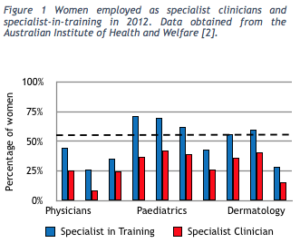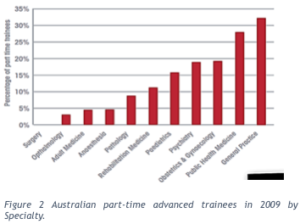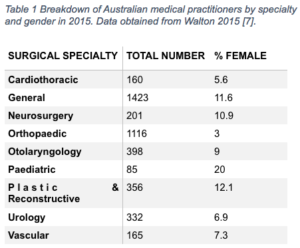Gender Equity in Medical Specialties
Author: Nicole Seebacher
Background
Today, women make up more than half of medical school graduates, yet they remain under-represented in most speciality areas. With a majority of female medical students for two decades, and medical school and specialty training taking between 9-12 years, it could be expected that parity in specialisation would have been reached by 2008. [6] While women are becoming more evenly represented in specialist-in-training programs, they still remain far behind in many specialties, most notably surgery [2] Less than 3% of female doctors are surgeons[7]. As of 2015, 10% of surgical fellows are female [7].
Studies have shown that female doctors perform equally as well as their male peers on measures of medical knowledge, communication skills, professionalism, technical skills, practiced based learning and clinical judgement [3,5].
At present, there is insufficient and incomplete information about the underlying causes of why female doctors are underrepresented in many specialties. A more systematic approach to understanding and addressing these disparities is needed.
Reasons why women are opting away from surgery
The enthusiasm of medical students for surgery has been shown to markedly decline upon graduation. Although there is limited data, research suggests that during medical school, interest in surgical careers drops (by half in one study [10]) as prospective candidates are dissuaded by the hours of work and lack of flexibility. Other reasons to not pursue surgery were identified as the surgical lifestyle (66.7%), the surgical work environment (53.3%), and the surgical training requirements (33.3%). Interestingly, only 36.7% was due to a lack of interest in surgery [11].
While the reasons for not pursuing a surgical career were similar for both men and women, those that have been consistently reported to be of particular significance for women, include: (1) The perception that surgery is incompatible with a rewarding family life, happy marriage, or the desire to have children [12]; (2) Inflexibility of the training program [13]; and (3) Male domination of surgery and the lack of female role models, with associated gender-based discrimination experienced during surgical rotations [14-17].

Reasons why women are opting out of surgical training
Surgical Lifestyle
Surgical training is rigorous and the lifestyle that accompanies a busy surgical practice is taxing, particularly for families. Surgical trainees have little control over on call rosters and are required to regularly move locations, making childcare and schooling complicated. In addition to this, trainees have ongoing educational commitments, creating difficulties for parents wishing to study in addition to working an average 60 hour week.
Flexibility of Surgical Training
A 2011 survey by the Royal Australasian College of Surgeons Trainee Association (RACSTA), reported that only 0.3% of surgical trainees were currently training part-time, but that 33.8% had expressed an interest in undertaking less than full-time training. In the 2012 Women in Surgery committee’s white paper “Flexible surgical training in Australia: it’s time for change”, it was reported that flexible and/or part-time training had no decline in quality of trainees in the specialities that offer flexible training [21, 22].
Role Models
A lack of role models (e.g. those with formal leadership roles, e.g. senior surgeons, departmental heads, or professors) is another key factor discouraging women from selecting a career in surgery [16, 26, 27]. Specialty medical programs with higher proportions of females in faculty achieve higher numbers of female trainees [28]. Some studies have suggest that the gender of role models changes stereotypes, increases identification with the role, and increases the perception of one’s own abilities [29].
Gender Based Discrimination
In a study of 334 members of the Association of Women Surgeons, 87% experienced gender-based discrimination in medical school, 88% in residency, and 91% in practice [15]. The study identified that the perceived sources of gender-based discrimination where their superiors, physician peers, clinical support staff, and patients. Notably, of these discriminatory events, 40% emanated from women and 60% from men [15].
An Expert Advisory Group formed by RACS has outlined extensive and systemic gender-based discrimination towards female surgeons. The report showed lower salaries, fewer opportunities for career advancement, different referral patterns from other doctors, less personal support or mentoring, a lack of senior female surgeons as role models, less respect or a different level of responsiveness from the medical team, bias against pregnancy and family responsibilities, and an ‘old boys club’ culture [31]. Compared with men, women were more likely to be deterred by their perceptions of the surgical personality and the view of surgery as an ‘old boys’ club’ [17].
Progress on Gender Equity in Specialties
Colleges
RACS has introduced a policy supporting flexible surgical training. However, they admit that the current surgical clinical training environment is not conducive to establishing posts that are less than full-time [34]. RACS recently established the ‘Flexible Training Working Party’ to look at how to make part-time training a possibility for surgical trainees. Members include jurisdictional representatives (ie, hospital and health department), and representatives from Colleges with a higher uptake of part-time training than the RACS. It is important to note that while the College can accredit trainee posts, it does not create posts or employ trainees.
Medical Associations
The Australian Medical Association (AMA) is working alongside specialist Colleges to encourage flexible training arrangements and job-sharing. The AMA released a discussion paper regarding Flexible Surgical Training, “Flexibility in Medical Work and Training Practices”, which offers ways of implementing flexible work and training arrangements.
Hospitals
After lobbying the state government, the Royal Adelaide Hospital has successfully implemented a part-time surgical training model [4]. All trainees that completed the 12 month, accredited, government funded, stand-alone, 0.5 full-time equivalent position, have subsequently passed their RACS Fellowship examination in General Surgery. [4, 35]
What still needs to change?
Resolving the discrepancy between the number of female medical students and the number of specialist female clinicians remains a complex problem. Priority issues include:
Mentoring and role-modelling: Medical schools and Hospitals play an important role as the facilitators of the first formal contact of medical students with the surgical profession during hospital-based surgical rotations. This represents a time where gendered perceptions of surgery may be contradicted or reinforced. Therefore, Medical schools need to expose students to a diverse range of surgical role models, as clinical tutors, lecturers or student mentors.
Flexible training: The extent of the demand for flexible training and its benefits needs to be systematically assessed [36]. A range of potential models could be adapted for medical training purposes, including: full-time flexible (start late, finish late), part-time flexible, and a job-share [37]. Research is needed determine the impact on educational outcomes, the minimum level of training required to maintain skills, and how competencies may be affected by intermittent breaks in training. This can be assisted through the Colleges and governments increasing the transparency of their information regarding previously successful programs.
Ending discrimination and harassment: Hospitals and Colleges should set clear and consistent standards, and enforce accountability for professional behaviour.
Priorities for Level Medicine
- Supporting the development of formal and evidence-based retention strategies, including mentoring support programs and flexible training pathways.
- Supporting data collection and research into barriers to females in specialty training programs
- Creating forums for discussion and building advocacy capacity in medical students and junior doctors.

References
- 1. Tomlinson, J., Flexible Surgical Training Let’s expand the opportunities, in Surgical News 2013: https://www.surgeons.org.
- 2. AIHW, Medical workforce 2012. 2014, National health workforce series no. 8.: Canberra.
- 3. Thomas, W., Teaching and Assessing Surgical Competence. Ann R Coll Surg Engl, 2006. 88(5): p. 429-32.
- 4. Neuhaus, S., et al., Part-time general surgical training in South Australia: its success and future implications (or: pinnacles, pitfalls and lessons for the future). ANZ J Surg, 2012. 82(12): p. 890-4.
- 5. Pico, K., et al., Do Men Outperform Women During Orthopaedic Residency Training? Clin Orthop Relat Res, 2010. 468(7): p. 1804-8.
- 6. Zealand, M.D.A.a.N., 2016 Medical Students Statistics. 2016, Medical Deans Australia and New Zealand: //www.medicaldeans.org.au/.
- 7. Walton, M.M., Sexual equality, discrimination and harassment in medicine: it’s time to act. Med J Aust, 2015. 203(4): p. 167-9.
- 8. RACS, Activities Report For the period: 1 January – 31 December 2010. 2010, Royal Australasian College of Surgeons: https://www.surgeons.org/media/306330/rpt2010_jan_to_dec_eoy_ar.pdf.
- 9. 2011, R., Surgical Workforce Projection to 2025. Royal Australasian College of Surgeons: //www.surgeons.org/media/437871/rpt_racs_workforce_projection_to_2025.pdf.
- 10. Shirley, O.C., B. Addison, and P. Poole, Who wants to be a surgeon? Patterns of medical student career choice. N Z Med J, 2014. 127(1405).
- 11. Rogers, M.E., P.A. Creed, and J. Searle, Why are junior doctors deterred from choosing a surgical career? Aust Health Rev, 2012. 36(2): p. 191-6.
- 12. Burgos, C.M. and A. Josephson, Gender differences in the learning and teaching of surgery: a literature review. Int J Med Educ, 2014. 5: p. 110-24.
- 13. Tomlinson, J., Flexible Surgical Training in Australia: It’s Time For Change. 2102, Women in Surgery Section, Royal Australasian College of Surgeons: //www.surgeons.org/media/18744675/ppr_2012-01-04_flexible_surgical_training.pdf.
- 14. Saalwachter, A.R., et al., The training needs and priorities of male and female surgeons and their trainees. J Am Coll Surg, 2005. 201(2): p. 199-205.
- 15. Bruce, A.N., et al., Perceptions of gender-based discrimination during surgical training and practice. Med Educ Online, 2015. 20: p. 25923.
- 16. Richardson, H.C. and N. Redfern, Why do women reject surgical careers? Ann R Coll Surg Engl, 2000. 82(9 Suppl): p. 290-3.
- 17. Gargiulo, D.A., N.H. Hyman, and J.C. Hebert, Women in surgery: do we really understand the deterrents? Arch Surg, 2006. 141(4): p. 405-7; discussion 407-8.
- 18. Slater, K., Pregnancy and Surgical Training By Kellee Slater FRACS general surgeon and mother of four. 2014, Royal Australasian College of Surgeons: //www.generalsurgeons.com.au/.
- 19. FACS, Surgical Career Lifestyle Issues, A.C.o. Surgeons, Editor.
- 20. Ahmadiyeh, N., et al., Career satisfaction of women in surgery: perceptions, factors, and strategies. J Am Coll Surg, 2010. 210(1): p. 23-8.
- 21. Price, J., Women cut apart by surgical culture, in Sydney Morning Herald. 2012, Fairfax Media: //www.smh.com.au/federal-politics/women-cut-apart-by-surgical-culture-20121217-2bj7l.html.
- 22. McClelland, B., Report Card on Surgical Education in Surgical News. 2010, Royal Australasian College of Surgeons: //www.surgeons.org/media/18532/SurgicalNewsv11_06.pdf.
- 23. Katelaris, A., “The Women in Surgery Committee was established to encourage and support all trainees, but females in particular” – RACS Women in Surgery. Med J Aust, 2011. 194(9): p. 435.
- 24. RACS, Appropriate Working Hours for Surgical Training in Australia and New Zealand. 2012. Reviewed 2016: //www.surgeons.org/media/21134024/2013-10-30_pos_eta-set-042_safe_working_hours_for_surgical_training.pdf.
- 25. Martin, J.A., et al., Objective structured assessment of technical skill (OSATS) for surgical residents. Br J Surg, 1997. 84(2): p. 273-8.
- 26. Park, J., et al., Why are women deterred from general surgery training? Am J Surg, 2005. 190(1): p. 141-6.
- 27. Gabram, S.G., L.W. Allen, and P.J. Deckers, Surgical residents in the 1990s. Issues and concerns for men and women. Arch Surg, 1995. 130(1): p. 24-8.
- 28. Neumayer, L., et al., Perceptions of women medical students and their influence on career choice. Am J Surg, 2002. 183(2): p. 146-50.
- 29. Dasgupta, N., Ingroup Experts and Peers as Social Vaccines Who Inoculate the Self-Concept: The Stereotype Inoculation Model. Psychological Inquiry, 2011. 22(4): p. 231-246.
- 30. Dengate, C., I Look Like A Surgeon: Australian Doctor Joins Global Female Movement, in Huffington Post. 2015, HuffPost Australia: //www.huffingtonpost.com.au/2015/08/19/i-look-like-a-surgeon-australian-doctor-joins-global-female-mov/.
- 31. Knowles, R., et al., Expert Advisory Group on discrimination, bullying and sexual harassment. Advising the Royal Australasian College of Surgeons. 2015, Expert Advisory Group: //www.surgeons.org/media/22086656/EAG-Report-to-RACS-FINAL-28-September-2015-.pdf.
- 32. Murphy, F., R. Spooner, and J. Medew, Surgical forum under fire for Melbourne boys’ club gala dinner venue, in The Age. 2016: //www.theage.com.au/victoria/surgical-forum-under-fire-for-melbourne-boys-club-gala-dinner-venue-20160726-gqe8ou.html.
- 33. Lillebuen, S., Senior surgeon Gabrielle McMullin stands by advice for female doctors to stay silent on sex abuse, in Sydney Morning Herald. 2015, Fairfax Media: //www.smh.com.au/.
- 34. SET, Trainee registration and variation policy (ETA-SET-010). Clause 3.4: part time training. 2011, Surgical Education and Training Department, Royal Australasian College of Surgeons: Melbourne.
- 35. Williams, S.A., Flexible surgical training in Australasia. Med J Aust, 2013. 198(8): p. 426.
- 36. Carling, P.C., et al., Part-time residency training in internal medicine: analysis of a ten-year experience. Acad Med, 1999. 74(3): p. 282-4.
- 37. Mahady, S.E., Adding flexibility to physician training. Med J Aust, 2011. 194(9): p. 460-2.
- 39. NHS, Flexible Careers Scheme for NHS Hospital Doctors 2004, FCS Guideleines for Hospital Doctors: //www.nhsprofessionals.nhs.uk/download/doctors-services/fcs-for-doctors.pdf.
- 38. Whitelaw, C.M. and M.C. Nash, Job-sharing in paediatric training in Australia: availability and trainee perceptions. Med J Aust, 2001. 174(8): p. 407-9.
To download a PDF copy of this research click here: Gender Equity in Medical Specialties.
